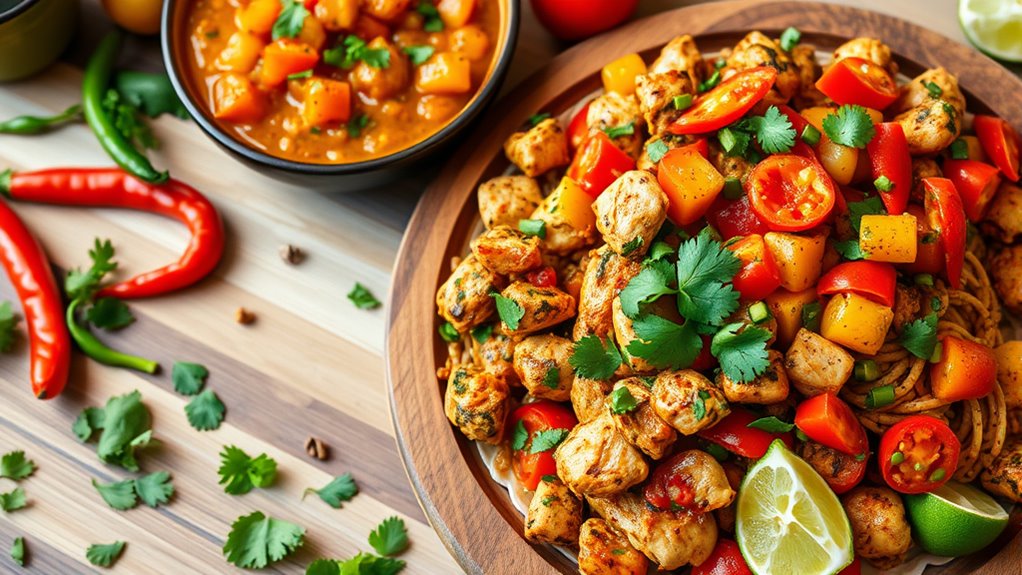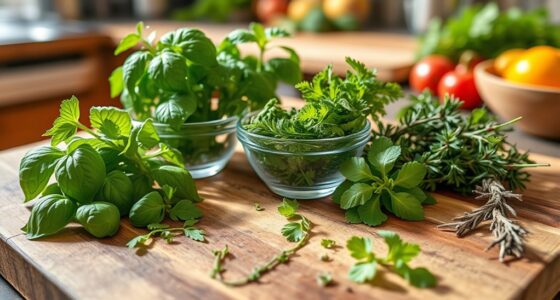Discover how to creatively blend global cuisines in your home cooking by experimenting with spice blends, presentation techniques, and core ingredients. Use herbs, aromatics, and bold flavors to craft complex dishes that celebrate cultural diversity. Play with colors, textures, and garnishes to make your meals visually stunning. Balancing flavors is key, so taste and adjust as you go. Keep exploring these techniques to unfasten exciting fusion possibilities that make every meal a culinary adventure.
Key Takeaways
- Use spice blending techniques to create complex, authentic flavors by combining herbs, ground spices, and aromatics from different cuisines.
- Incorporate diverse ingredients like miso, chipotle, and herbs to craft fusion sauces that balance bold flavors.
- Enhance presentation with contrasting colors, garnishes, and artistic plating to elevate the visual appeal of fusion dishes.
- Taste and adjust seasonings throughout cooking to achieve harmonious flavor balance and prevent overpowering elements.
- Tell a cultural story through thoughtful ingredient pairing and creative presentation, making each dish a culinary journey.

Exploring global cuisines at home brings exciting flavors and new techniques right to your kitchen. As you experiment with different culinary traditions, you’ll discover how spice blending can transform simple ingredients into complex, memorable dishes. Creating your own spice blends allows you to customize flavors, combining herbs, ground spices, and aromatics to evoke the essence of cuisines like Indian, Middle Eastern, or Southeast Asian. For instance, mixing cumin, coriander, and turmeric can produce a vibrant curry powder, while blending cinnamon, allspice, and cloves can evoke warm North African flavors. The key is to taste as you go, adjusting proportions to suit your palate and the dish’s requirements. These blends not only deepen flavors but also add authenticity to your fusion creations.
Presentation techniques play a vital role in elevating your dishes from everyday meals to visually stunning plates. When you combine global cuisines, it’s essential to think creatively about how you serve your dishes. Use contrasting colors, varied textures, and thoughtful garnishes to make each plate inviting. For example, garnish a spicy Thai curry with fresh herbs, lime wedges, and colorful chili slices, or serve a Moroccan-inspired tagine with a sprinkle of chopped cilantro and a drizzle of yogurt. Plating techniques borrowed from different culinary traditions can add an artistic touch—try stacking components, using edible flowers, or drizzling sauces artistically to enhance visual appeal. Remember, presentation is not just about making your dish look good; it’s about creating an experience that excites the senses.
Blending flavors from different regions also involves understanding their core ingredients and cooking methods. You might take the smoky richness of Mexican chipotle peppers and combine it with the fragrant spices of Indian garam masala, creating a unique fusion sauce. Or, incorporate the tang of Japanese miso into a Mediterranean hummus for a savory twist. As you experiment, you’ll learn how to balance bold flavors, ensuring no single element overpowers the others. This delicate balancing act is where your creativity shines, and it’s essential to keep tasting and adjusting your spice blends, seasoning, and presentation until everything harmonizes.
In the end, combining global cuisines in your home cooking is about more than just mixing ingredients—it’s about storytelling through flavors and visuals. With careful spice blending and innovative presentation techniques, you can craft dishes that are both delicious and visually mesmerizing. Each fusion creation becomes an artistic expression of cultural appreciation, allowing you to travel the world without leaving your kitchen. So, embrace the adventure, keep experimenting, and enjoy the rich tapestry of flavors you bring to your table.
Frequently Asked Questions
How Can I Ensure Balanced Flavors in Fusion Dishes?
To guarantee balanced flavors in fusion dishes, focus on ingredient pairing and flavor balancing. You should taste as you cook, adjusting seasonings to harmonize the diverse elements. Use contrasting flavors like sweet and spicy carefully, and incorporate fresh herbs or acids to brighten the dish. Keep the proportions in check, and don’t shy away from experimenting gradually—this way, you create a cohesive, delicious fusion that highlights each cuisine’s unique qualities.
What Are Common Pitfalls When Combining Different Cuisines?
Oh, the irony of blending cuisines—thinking you’ll create something authentic? Be careful, as common pitfalls include ignoring regional authenticity and disrupting flavor harmony. You might end up with a confusing mash rather than a delightful fusion. To avoid this, research each cuisine’s unique elements and balance bold flavors carefully. Respect the origins, and your dish will feel both innovative and genuine, not just a confusing jumble.
How Do I Select Authentic Ingredients for Fusion Recipes?
To guarantee flavor authenticity, focus on ingredient sourcing from reputable suppliers or specialty markets that offer authentic, high-quality products. Research traditional ingredients for each cuisine you’re blending, and look for authentic labels or certifications. Don’t settle for substitutes that might alter the flavor profile. By sourcing genuine ingredients, you’ll preserve the integrity of each cuisine and create a delicious, authentic fusion dish that respects its cultural roots.
Are There Cultural Considerations to Respect in Fusion Cooking?
Yes, there are cultural sensitivities to consider in fusion cooking. You should respect traditions by researching the origins of ingredients and dishes, avoiding stereotypes, and being mindful of cultural significance. Approach blending flavors with appreciation rather than appropriation, and take into account consulting cultural sources or community members when unsure. This respectful approach ensures your fusion creations honor the cultures they draw inspiration from, fostering understanding and appreciation.
How Can I Adapt Fusion Recipes for Dietary Restrictions?
Think of adapting fusion recipes as updating your vintage tech—it’s all about making it work for today’s needs. You can create gluten-free adaptations by swapping out traditional ingredients with rice noodles or cauliflower rice, and use vegetarian substitutions like tofu or chickpeas to replace meat. Always check labels and ingredient lists, and be mindful of cross-contamination to guarantee your dish respects dietary restrictions while still delighting the palate.
Conclusion
By blending global cuisines in your home cooking, you not only create exciting flavors but also embrace cultural diversity. Some say that fusion cooking reflects our interconnected world, fostering understanding and innovation. While critics argue it risks diluting authentic traditions, many believe it sparks creativity and personal expression. Ultimately, experimenting with different cuisines allows you to develop your palate and challenge culinary boundaries, making each meal a unique celebration of global flavors.









